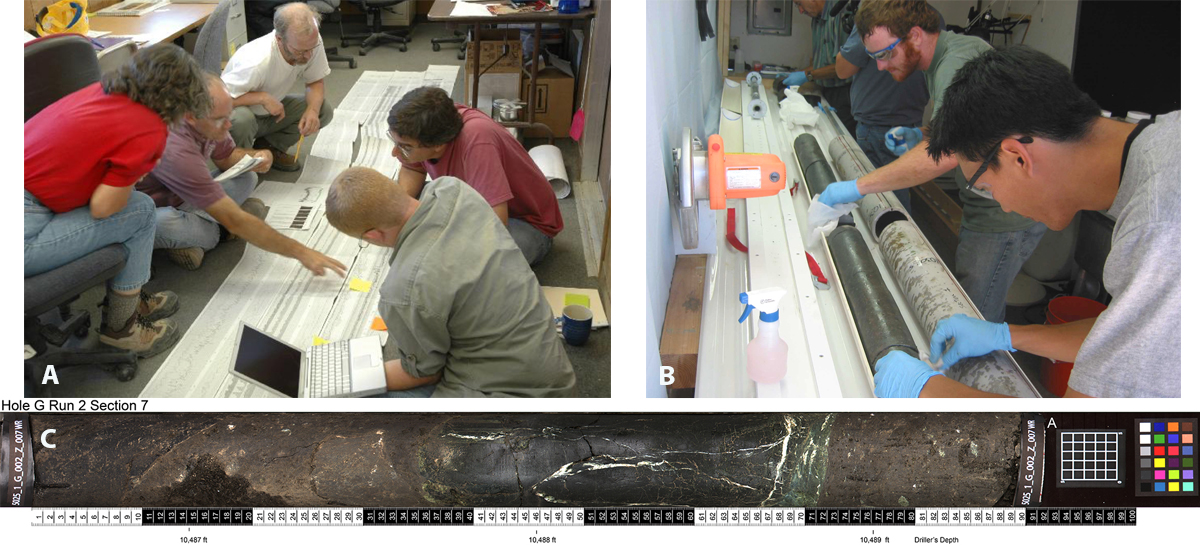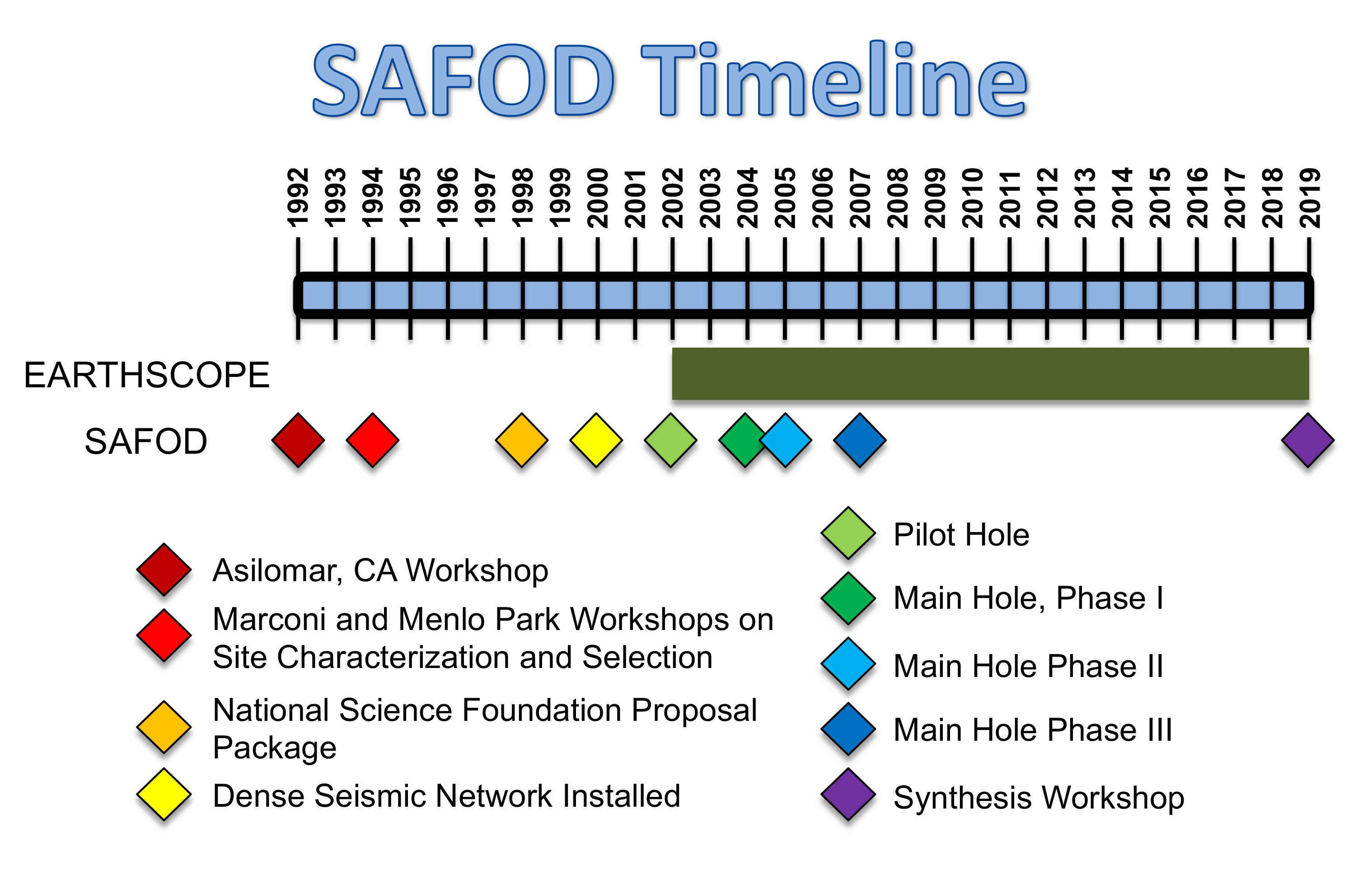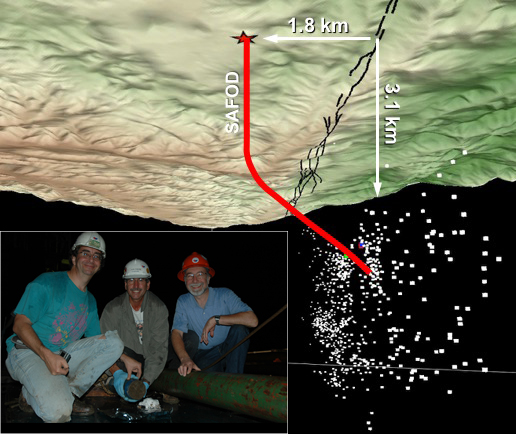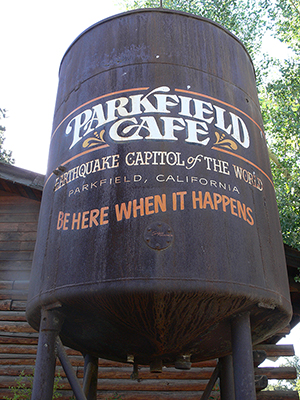Photos above: A) Phase II science team members reviewing wireline logging data. B) Phase III core science team members exposing and processing recovered core. C) SAFOD G27 core containing part of the SAF from about 3km depth. This core answered one of the main unknowns concerning the role of serpentine and the creeping behavior of the central San Andreas Fault.
by Brett M. Carpenter and Judith S. Chester
With the end of the EarthScope program upon us, we reflect on its overarching goal to “Unlock the Secrets of the North American Continent” through a bold multidisciplinary initiative designed to explore the complexity of critical geologic processes. The San Andreas Fault Observatory at Depth (SAFOD), one of the three components of this enterprise, provided the opportunity for scientists to collect key physical and chemical data from an active plate-boundary fault at earthquake depths to test long-standing hypotheses about faulting processes and earthquake generation.
First-order Scientific Questions
Taken from Zoback et al. (2011).What are the mineralogy, deformation mechanisms, and constitutive properties of fault gouge?
What is the fluid pressure and permeability within and adjacent to fault zones?
What are the composition and origin of fault-zone fluids and gases?
How do stress orientations and magnitudes vary across fault zones?
How do earthquakes nucleate?
How do earthquake ruptures propagate?
How do earthquake source parameters scale with magnitude and depth?
What are the physical properties of fault-zone materials and country rock (seismic velocities, electrical resistivity, density, porosity)?
What processes control the localization of slip and strain?
The San Andreas Fault Observatory at Depth (SAFOD) is a 3-kilometer deep borehole across the San Andreas fault located midway between San Francisco and Los Angeles, near the town of Parkfield, California. This location is coincident with the southern end of the creeping section of the fault, marking the transition to the locked portion that extends southward. Creep is a slow, stable type of fault slip, while at the opposite end of the spectrum is the sudden, unstable slip resulting in an earthquake. At the drill site the San Andreas fault is multistranded, meaning that the fault is composed of a set of parallel and subparallel localized slip zones within a larger fault system (see the SAFOD borehole image). In the Parkfield region, the Pacific plate has slid more than 300 km northward relative to the North American plate.
Photo: Seismicity of the San Andreas Fault as seen from a vantage point in the earth looking to the northwest (locations determined by Zhang and Thurber). The SAFOD borehole is shown in red, extending downward from the surface facility (star). The surface trace of the fault is shown in black draped over the topography and earthquake hypocenters (origin points) are shown as white dots. (3-D EarthVision plot by Luke Blair, USGS). Inset: Principal investigators (left to right) Stephen Hickman, Mark Zoback, & William Ellsworth.
The Parkfield location, near the town advertised as the “Earthquake Capital of the World” on the famous local water tower, was selected from 18 potential SAFOD sites. The Parkfield drill site offered the ability to expand and capitalize on an extensive data set and understanding of the San Andreas fault already gained from long-standing, comprehensive U.S. Geological Survey and California Geological Survey research programs initiated in the 1980s. It was (and still is) one of the best-characterized segments of a continental transform fault in the world. The fault segment at this site also held the expectation of a magnitude ~6 earthquake occurring close by in the near future, and the unusual opportunity to target an area of repeating earthquakes and fault creep from the same borehole.
(Water tower photo by Creative Commons image: Linda Tanner from Los Osos & Creston, California, U.S.A.)
Site characterization efforts included workshops, geological mapping, geophysical surveys, installation of dense seismometer networks, and the drilling and instrumentation of the Pilot Hole in 2002. These efforts culminated in the publication of a special section of Geophysical Research Letters: Preparing for the San Andreas Fault Observatory at Depth in 2004.
The SAFOD project was an ambitious undertaking with equally ambitious goals. Significant technical and scientific accomplishments resulted from this campaign:
The SAFOD borehole was the first to cross a plate-boundary fault at earthquake depths, and remains one of the deepest boreholes into a major plate boundary in the world.
The borehole was the first to directly document the location of fault creep at depth.
We achieved almost 100% recovery of rock core samples from two fault strands that are actively slipping at earthquake depths.
We found that slip between the North American and Pacific tectonic plates in central California takes place along a few remarkably narrow (2- to 3-meter-wide) zones of highly localized active creep embedded within a much broader (200-meter-wide) damage zone.
Borehole measurements and measurements on the core samples document that the fault slips easily at low stresses—it is “weak”—while the crust around it is strong. The strength of the San Andreas fault had been long debated.
We know that the fault behavior observed at this location and depth is related to the presence of exceedingly weak minerals. These minerals formed during ongoing chemical reactions within the fault due to association with and juxtaposition of different rock types reflecting the rich tectonic history of the San Andreas fault zone.
Borehole instruments currently sit 50–100 m from repeating microearthquakes.
The SAFOD project demonstrates that we can penetrate, study, and sample an active fault at earthquake depths, and that we have the capability to establish a long-term observatory directly within an actively deforming plate boundary. It demonstrates that we can recover remarkable, intact, continuous rock core to provide a suite of unprecedented samples, never before obtained, that can foster far-reaching discoveries about fault properties and the faulting process. The drill hole also revealed the harsh chemical and thermal environment that down-hole instruments need to withstand for successful long-term, near-field monitoring of an active fault zone at earthquake depths.
The past, present, and future of the SAFOD project was reviewed at the recent SAFOD Synthesis Workshop held Oct 12–14, 2018 at Stanford University. The workshop highlighted the successes of the SAFOD project, critical scientific questions that could be addressed through future use of the SAFOD borehole and core samples, and steps needed to address these questions. Short-term objectives include securing funding to instrument the existing borehole with a fiber-optic cable and seismometer to provide continuous near-field seismic data. Longer-term plans include organizing a science team to develop a possible SAFOD Phase IV. The new phase would build off the many successes fostered by the EarthScope initiative.
Although the EarthScope program will be ending, samples and data from SAFOD will continue to provide insights into the physical and chemical processes controlling faulting and fault-zone processes for years to come. Some data are found in the publications list on the EarthScope website and other data on the International Continental Scientific Drilling Program (ICDP) website. The physical samples are curated at the Gulf Coast Repository on the Texas A&M University campus in College Station, Texas.
SAFOD started as a conversation, continued to develop through expanding interactions, and was formalized into a detailed science plan during an international workshop held in Asilomar, California in 1992. As the community moves forward in the next phase of our quest to understand earthquake behavior, we thank the SAFOD Principal Investigators, Mark Zoback, Stephen Hickman, and William Ellsworth for leading this mission to explore new frontiers in our field, and the National Science Foundation, U.S. Geological Survey, and ICDP for supporting this bold and insightful initiative.
We know that additional critical scientific information clearly is within our reach as we go forward. Stay tuned!
References
Geophysical Research Letters: Preparing for the San Andreas Fault Observatory at Depth (20 papers) Vol. 31, Nos. 12 and 15, 2004.
Zoback, M.D., Hickman, S., and Ellsworth, W., 2007. The role of fault zone drilling. In Kanamori, H., and Schubert, G. (Eds.), Earthquake Seismology—Treatise on Geophysics Vol. 4: Amsterdam (Elsevier), 649–674.
Zoback, M. D., S. Hickman, W. Ellsworth, and the SAFOD Science Team (2011), Scientific drilling into the San Andreas Fault Zone—An overview of SAFOD’s first five years, Sci. Drill., 11, 14-28, doi:10.2204/iodp.sd.11.02.2011








